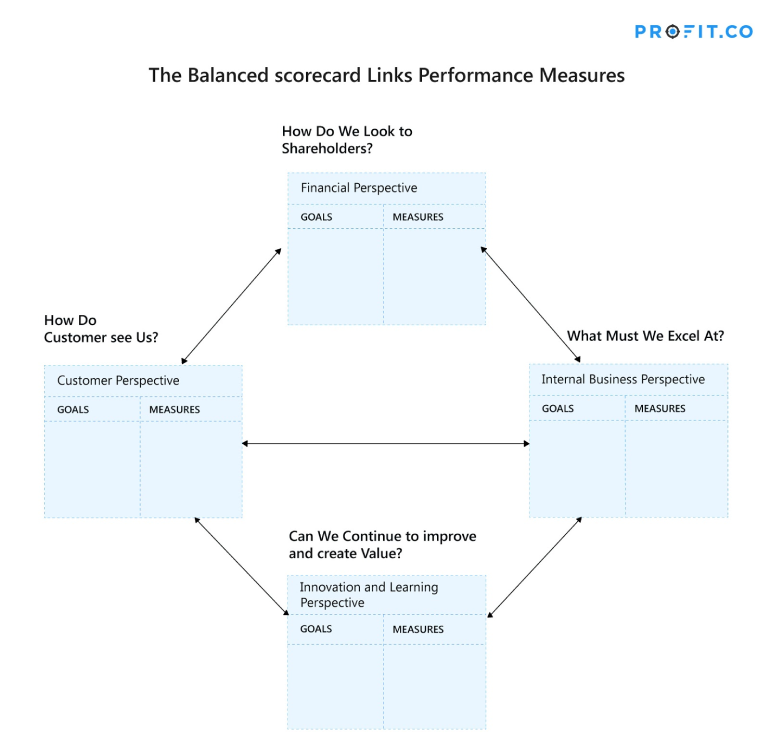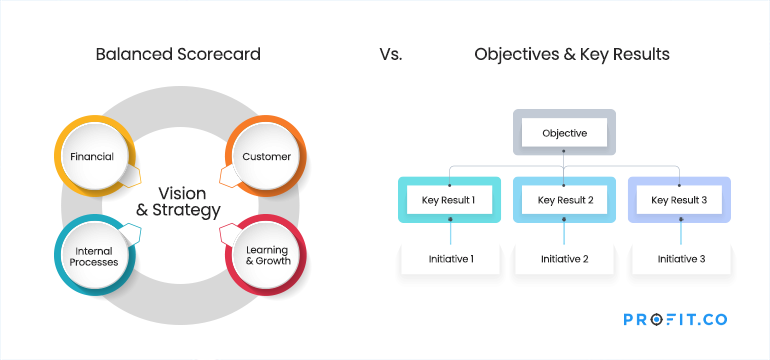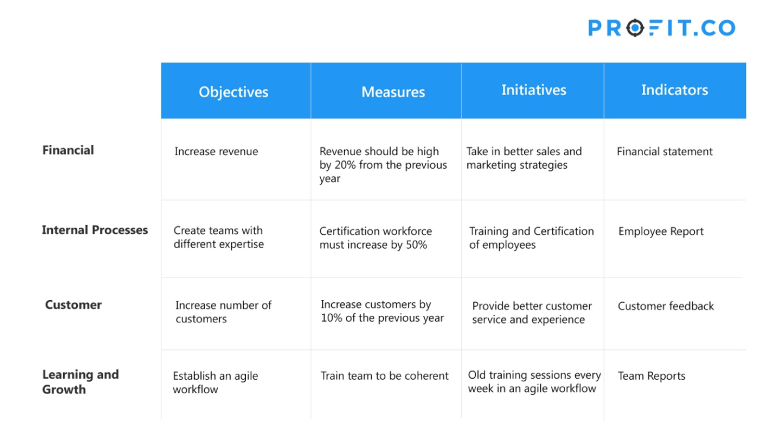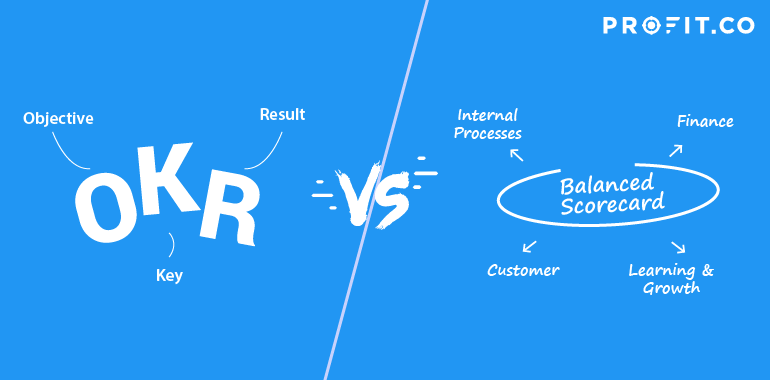Businesses are established with one thing in mind: growth. All companies whether they are large enterprises or garage start-ups– strive to expand their business and earn more revenue. Increasing production and skillful marketing are major drivers of success. Since any organization is made up of its employees, creating an uplifting environment for your employees is the key to ultimately grow your business.
Managing your team’s performance can greatly enhance your business. The objective and key result (OKR) framework and Balanced Scorecards are evaluation systems that grade the performance of the employees. They both focus on morale-boosting to increase the efficiency of your team. With Profit.co’s OKR management software you can be assured to get the best results.
What is a Balanced Scorecard?
Balanced Scorecard Software, often abbreviated as BSC, is a strategic management system that organizations use to highlight what they intend to accomplish, connect daily tasks to overarching strategy, prioritize projects, and measure progress towards their most important targets.
Balanced Scorecards aim to achieve goals by monitoring four static categories. These 4 aspects of the Scorecard are interrelated to each other. They are Financial Aspect, Internal Process Aspect, Learning and Growth Aspect and last but definitely not the least, Customer Aspect. All “goals” must be fitted into one of the features. Once the goals are set, users must set “measures” in order to achieve the targets. Then, an “initiative” must be outlined, and an “indicator” of success must be determined. With all of these elements correctly added, the BSC looks something like this:

As you can see in the above image, each aspect of the BSC is connected. Since there are so many aspects functioning at the same time, you can have multiple goals set.
Objectives and Key Results
Objectives and Key Results is a powerful and agile goal-setting framework that allows individuals and teams to stretch productivity beyond what they thought possible.
OKRs are commonly set on a quarterly basis, and users should define no more than 3-5 Objectives per department, team, or individual user. Objectives are statements that are general, ambitious, and memorable, capturing the most important goals that the group wants to achieve in a given quarter. Then, these objectives are made quantifiable using keyResults. There should be no more than 3-5 key results for each objective defined. Key results must be measurable or trackable outcomes that are a mutually exclusive and collectively exhaustive list that, when completed, signals that the attached objective has been fulfilled.
Profit.co’s Objectives and Key Results application is built to encompass the thoughts of the team. The team members decided what is important and what will be focused on first. Instead of having to align expansion plans with set standards from before, OKRs provide you with more control over your concept. The idea is to have a more streamlined version of project progress.
Objectively Different
While OKRs and BSCs are both tools to manage and overlook performance or productivity, there is a significant difference between these two frameworks. And this difference comes in their strategies.

With a Balanced Scorecard, you have to form a strategic map to attain your goals, separated into 4 parts. Each part of Finance, Customer, Internal Process, and Learning and Growth comes with goals. So, a BSC can have 10-15 goals at one time. The success of each sector can be measured by the achieved goals. It is also a holistic approach. OKRs, on the other hand, bring flexibility and encourage teams to align to top level OKRs and also align across teams thereby enhancing ownership, empowerment and accountability.
To understand how it works, for example, consider this table of an app development company:

OKRs are usually top-down processes; they focus on the bigger picture first and decide on the smaller goals needed to be met to reach the target. By limiting the number of OKRs per team within a quarter to 3-5, employees are not overburdened, and teams can avoid having unbalanced OKR progress. It also provides employees with autonomy and lets them decide on what to focus on first.
For example, consider the same app development company using OKRs:
The company has decided to implement OKRs. Therefore, the main objective will be reached by having planned smaller goals or KRs.
Where can OKRs be used?
OKRs are a method of constant tracking for your employees. Regular updates are provided with the use of this framework that help keep everyone up-to-date and fully aligned. Industry-leading companies such as Google and Twitter use this system as a way to keep people informed of the company’s top priorities and to increase employee engagement. OKRs can work as a major morale-booster as teams see they are making a real impact in their organizations. Additionally, teams can feel satisfied and fulfilled as they check-in key results with continued weekly progress.
The Profit.co method is agile and lightweight. It encourages engagement and can be quickly adjusted to encompass any changes that may arise during the unfolding of a project. It is used to make small goals and review regular updates.
Where can BSC be used?
If you are focused less on process and weekly engagement, OKRs can feel very specific. Companies that want to illustrate end-goals use BSCs. While OKRs are used for regular updates and reviewed every quarter (sometimes every month depending on the business model), BSCs are more effective in envisioning the final destination. They are built for more ambitious goals which may take many years to achieve. BSCs are generally inspected every year. The annual review allows for bigger goals.
Can they be used together?
While both of these strategic frameworks are useful in their own right, they work best when used harmoniously. Profit.co’s OKR system can be easily integrated with a BSC. A strategy model called ‘Two Speed Execution’ has been developed combining the strategy map of a BSC with the intricate objective definition of OKRs. BSCs are effective in creating long term goals for companies, while OKRs are great at breaking them down into smaller, more quantifiable results.
A Balanced Scorecard can be created as a way to initially outline strategy and major goals. Admins can then organize an OKR with the help of the information provided in BSCs. This has a more holistic approach to project management.
For instance, in a company when stakeholders and other higher authorities come together, they can collectively form the main organizational goals, using BSCs. As most of the healthy-functioning organizations utilize OKRs to set up micro-goals, the contribution is made from the employees to fulfill the BSC targets. Thus, BSC maps down objectives for each department, OKRs determine what will be the objectives to reach those goals.
OKRs vs Balanced Scorecard- which one will you choose?
Both BSC and OKRs are tools to manage performance and to track progress. As per their objectives and methodology of implementation, they are used in different scenarios. While it is believed that BSCs are suitable for annual or three-year target achievements, OKRs work best for shorter-term plans such as monthly or quarterly goals. OKRs are a newer form of progress evaluation but they are not structured to replace BSCs. You will benefit the most by using the 2 frameworks in unison.
Check out the detailed comparison between balanced scorecard and OKRs to find out which framework works best for your goals. If you’re ready to focus your priorities, measure your progress, and achieve your goals using an agile and adaptable goal-setting software, then you can get started with Profit.co completely free today, or book a demo with us to see what Profit.co’s powerful software can do for your organization.
| Perspective | Balanced Scorecard | OKR |
|---|---|---|
| Methodology | Most companies will draft objectives and measurements that are designed to stay in place for at least one year or more.When constructing a Balanced Scorecard, organizations create objectives and measures in four distinct, yet related perspectives of performance: Financial, Customer, Internal Processes, and Learning & Growth. | Most organizations change their Objectives and Key Results each quarter, focusing on what can create the most value in the next 90 days.OKRs do not have predefined categories. Individuals, teams, departments, and organizations decide what is most important in the next 90 days and align the organization from the bottom-up or top-down. |
| Advantage | Closely related to other aspects of performance and business, namely:
|
|
| Process | BSC is usually an entirely top-down process; the leadership goes off and designs top-level goals that are then cascaded down throughout the organization. This means employees are focusing on the most important thing for the organization. | OKR is done bottom-up, sideways, as well as top-down. With OKRs, people can set their own goals or at least have more input into the process, which means they are engaged with the objectives.It’s a transparent process, with OKRs visible across the entire company. |
| Implementation | BSC is often linked to compensation and bonuses, even if it’s only partially linked (such as financial indicators that inform bonuses). | OKR is separated from compensation and incentives, which allows individuals to set more ambitious goals they will need to stretch for rather than safe goals they know they will reach. |
| Focus | Management | Management & Operations |
